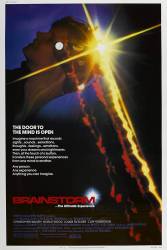Continuity mistake: From the very start, this movie's psychedelic visual effects (representing a test pattern grid) are rotating counter-clockwise in the background throughout the title sequence. This transitions to the opening scene in the lab, where the researchers are still trying to calibrate the test pattern grid. Christopher Walken, who is actually viewing the effects, complains that the grid is scrambled, out-of-phase and rotating. Louise Fletcher makes some technical adjustments and says, "What do you see, angel?" Walken answers, "Clockwise rotation." The shot instantly cuts to the visual-effects view again, to show us what Walken is seeing, and all of the grid effects are still rotating counter-clockwise. (00:00:50 - 00:03:00)
Continuity mistake: When Alex is trying out the device for the first time car 6 is in front of him but that is the car he is supposed to be in - it's the car that Gordy drove when collecting the data. (00:20:45)
Continuity mistake: As Alex is congratulating Mike and Lillian and saying the department heads need to be told, Lillian lights a cigarette. The camera switches to Alex, who says one sentence, then back to Lillian and the cigarette is almost gone. (00:22:00)
Continuity mistake: When Christopher Walken gives his wife a tape of his best memories, many of the shots are 3rd-person, of the two of them, and not 1st-person, from his perspective, like everyone else's recordings. (00:44:40)
Suggested correction: The device that records experience, esp. memory, is sometimes viewed in a non-logical way. This is because memories and emotions are not usually recalled exactly as they occurred. The brain is not a camera. There are complex mechanisms at work. I assume the filmmaker had this in mind.
Producer/director Douglas Trumbull knew that the montage of romantic memories was vital to establishing a backstory for the relationship between Christopher Walken and Natalie Wood. This montage was the first time we see the love they actually had for one another, so it was necessary to show them interacting on the screen. If Trumbull had stayed strictly with the movie's premise of first-person brain-recording technology, the montage of romantic memories would be nothing but closeup shots of Natalie Wood (from Walken's perspective), with no visual interaction between the couple. So, Trumbull violated the first-person technological premise of the film in order to more firmly establish the depth of their relationship. Trumbull did the same thing for Louise Fletcher's memory sequence. It was a matter of artistic license.
Continuity mistake: As Mike and Karen walk the aisle at Lillian's funeral, she links her arm with his. The camera cuts to a wider angle and they're not touching. (00:59:50)





